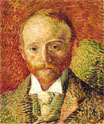 Throughout the 19th century Glasgow's industrial and commercial prosperity promoted an environment conducive to art. West of Scotland industrialists, keen to decorate their town houses, could purchase paintings from new exhibiting bodies like the Glasgow Institute of the Fine Arts (founded 1861, later Royal) and from the growing number of art dealers including William Craibe Angus (1830-1899) and Alexander Reid (1854-1928). These exhibitions and dealers provided a showcase for the work of local artists as did the International Exhibitions held in Glasgow in 1888 and 1901.
Throughout the 19th century Glasgow's industrial and commercial prosperity promoted an environment conducive to art. West of Scotland industrialists, keen to decorate their town houses, could purchase paintings from new exhibiting bodies like the Glasgow Institute of the Fine Arts (founded 1861, later Royal) and from the growing number of art dealers including William Craibe Angus (1830-1899) and Alexander Reid (1854-1928). These exhibitions and dealers provided a showcase for the work of local artists as did the International Exhibitions held in Glasgow in 1888 and 1901.
 Glasgow's artists were increasingly aware of contemporary continental European art - particularly that of Holland and France - whose influence can be seen on the work of the Glasgow Boys who flourished near the end of this period c.1880-1900. Responsible for the regeneration of Scottish art, W Y Macgregor (1855-1923), James Paterson (1854-1932), John Lavery (1856-1941), James Guthrie (1859-1930), Joseph Crawhall (1861-1913), E A Walton (1860-1922), George Henry (1858-1943) and E A Hornel (1864-1933) shared a dislike of the anecdotal, sentimental subjects of Victorian painting, preferring instead to paint realistic contemporary subjects of which Guthrie's A Highland Funeral is an important example.
Glasgow's artists were increasingly aware of contemporary continental European art - particularly that of Holland and France - whose influence can be seen on the work of the Glasgow Boys who flourished near the end of this period c.1880-1900. Responsible for the regeneration of Scottish art, W Y Macgregor (1855-1923), James Paterson (1854-1932), John Lavery (1856-1941), James Guthrie (1859-1930), Joseph Crawhall (1861-1913), E A Walton (1860-1922), George Henry (1858-1943) and E A Hornel (1864-1933) shared a dislike of the anecdotal, sentimental subjects of Victorian painting, preferring instead to paint realistic contemporary subjects of which Guthrie's A Highland Funeral is an important example.
 Quality of light, careful composition and a controlled yet painterly touch typify their work while Henry's Galloway Landscape with its rhythmic overall pattern and broad colour areas show how innovative their painting could be. By 1890 the Boys had gained international recognition, their paintings having toured in Europe and to the USA and Russia.
Quality of light, careful composition and a controlled yet painterly touch typify their work while Henry's Galloway Landscape with its rhythmic overall pattern and broad colour areas show how innovative their painting could be. By 1890 the Boys had gained international recognition, their paintings having toured in Europe and to the USA and Russia.